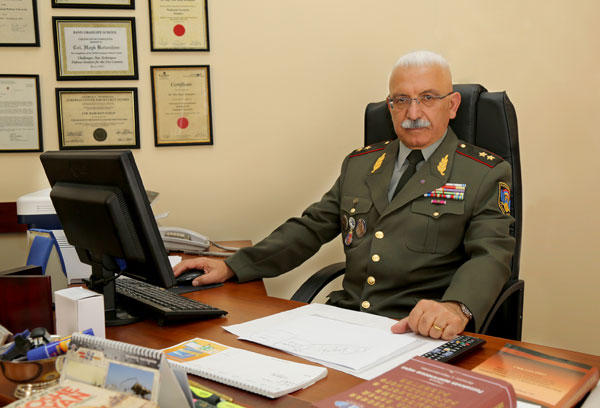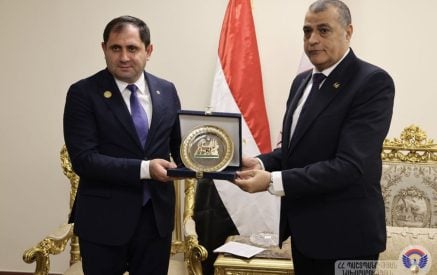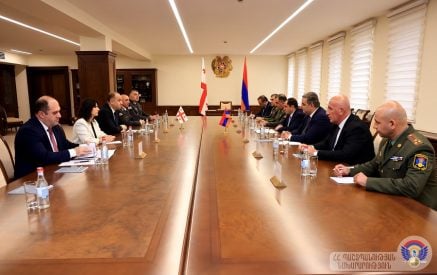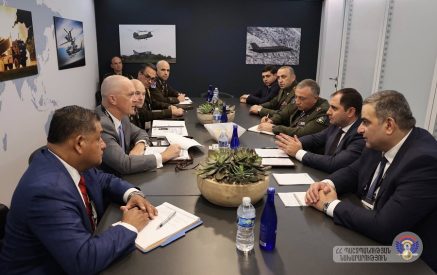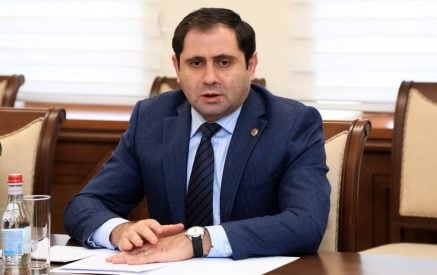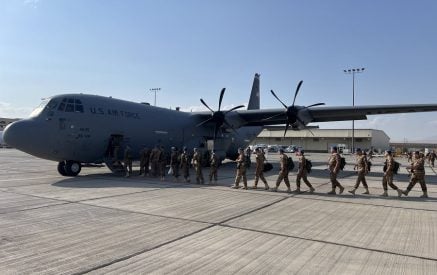HAYK S. KOTANJIAN, Lieutenant General, Doctor of Political Science, Professor, Distinguished Visiting Member of Faculty at the US NDU; Full Elected Member of the Academy of Military Sciences, the Russian Federation; Member of the CSTO Academic-Expert Council; Head of the National Defense Research University, MoD, Armenia.
Presentation at the Joint session of the Standing Committee on Foreign Relations of the National Assembly of the Republic of Armenia and the Committee on International Affairs of the State Duma of the Russian Federation.
Yerevan, November 19, 2016
Responding to one of the main topics of today’s joint session of Commissions of the National Assembly of the Republic of Armenia and the State Duma of the Russian Federation, I am honored to note that at the dawn of the “reset” in 2010, I happened to be an academic consultant of the “US‒Russia Strategic Dialogue” at Harvard Kennedy School of Government, attended by leading Russian and US generals and strategic-caliber analysts. This enables to professionally keep а close watch of the dynamics of US-Russian relations.
Being at the threshold of cold “peace-war” between Russia and the US, my colleagues, engaged in the search for platforms to continue the constructive dialogue between Russia and the US, mention the discrepancy of negotiations parties’ positions in the Minsk Format on Ukraine, as well as in talks on Syria. At the same time, the platform of the OSCE Minsk Group Co-Chairmanship on the Karabakh Conflict’s peaceful settlement stands out among political-diplomatic platforms of long-lasting and unbroken international security consensus in the positions of the US and the Russia. This unbroken consensus of the OSCE Minsk Group Co-Chairs ‒ the Permanent Members of the UN Security Council, the Russian Federation, the US and France, confirmed its exceptional value also in the Vienna Talks of May 2016. The convergence of positions of Russia, the US and France in Vienna consultations on the results of Four-day war in Karabakh in April this year led Armenia and Azerbaijan to agree on the need of establishing control over the preparations for war in the zone of the armed conflict to prevent the parties from the resumption of hostilities.
In the era of information-saturated means of war making and its prevention, the smart combination of technological innovations along with the methods of political-diplomatic influence on the preparation for combat operations pave the way for developing a concept of containment through effective information control over military forces’ accumulation and movement signaling war preparations. Such a strategy enables mediating parties-peacemakers to provide each other and the conflicting sides with real information about the peace-threatening preparations of either opponent in order to incline them to abandon the preparations for war.
In this sense, it is essential to proceed from the understanding that under the current trend towards the escalation of the arms imbalance between Armenia and NKR on the one side, and Azerbaijan – on the other, it is unacceptable to rely on the prevention of the resumption of hostilities by traditional military deterrence. In this regard, it is required to academically comprehend innovative approaches to cooperation with the international community aimed at utilizing its high-tech tools for the sensing of dangerous maneuvers of military forces signaling the preparations for expanded military operations. This is about the methodology we developed in the National Defense Research University of Armenia for attracting the OSCE Minsk Group Co-Chair States, the Permanent Members of the UN Security Council – France, Russia, and the US – to sense dangerous dynamics of force in the Karabakh conflict zone through the sighting aid from the supranational outer space with the employment of orbital facilities of remote sensing.
The International Space Law enables the international community to inspect from the near-Earth space the dynamics of the preparation of troops for the resumption of hostilities in the conflict zone. This kind of remote inspection with its shift from national airspace to supranational space can be used as an innovative tool of political-diplomatic containment through consultations and negotiations for preventing a war.
According to the Declaration of Legal Principles Governing the Activities of States in the Exploration and Use of Outer Space: “To promote and intensify international cooperation, especially with regard to the needs of developing countries, a State carrying out remote sensing of the Earth from space shall, upon request, enter into consultations with a State whose territory is sensed”,[1] and the Treaty on Principles Governing the Activities of States in the Exploration and Use of Outer Space, including the Moon and Other Celestial Bodies states that “Outer Space, including the Moon and other celestial bodies, is not subject to national appropriation by claim of sovereignty, by means of use or occupation, or by any other means”[2].
The application of this innovative method of containing the resumption of war through the use of orbital facilities of remote sensing by the mediating powers-peacemakers could become an effective tool in the case of the protracted Karabakh conflict smoldering on for more than a quarter-century in the immediate vicinity of the turbulent Middle East and being a strategically important factor for the regional security due to the Armenian-populated Karabakh’s proximity to Armenia, Azerbaijan, Georgia, Iran, and Turkey. This means that any resumption of hostilities in Karabakh may open a new chapter of genocide al tragedies across this region bridging the East and the West, where genocide of Christians, Jews, Yazidis, and Muslims, not engaged in the terroristic jihad, is now perpetrated by the torturers of the Islamic State.
The urgency of the “Never Again” principle for the Armenian people once again called forth during Perestroika in the USSR – at the time of pogroms committed by Azerbaijan against its Armenians population, in response to the Nagorno-Karabakh Armenians’ peaceful political actions for self-determination and withdrawal from the Azerbaijani SSR in compliance with the USSR legislation then in force[3].
On 23 November 1991, the Supreme Council of Azerbaijan passed a law on the dissolution of the Nagorno-Karabakh Autonomous Oblast (NKAO). In response to those illegal actions, on 10 December 1991, a referendum of independence was held in Nagorno-Karabakh strictly meeting international standards and the USSR Law of 3 April 1991, and in the presence of international observers. The Azerbaijani minority of NKR was given an opportunity to take part in the referendum. But on Baku’s instructions they declined that opportunity[4]. Subsequent events eliminated the imperative obligation of coordinating the results of the referendum with the USSR central bodies, since, on 21 December 1991, the Alma-Ata Declaration on the dissolution of the Soviet Union was signed[5]. Hence, the Referendum held on the territory of Nagorno-Karabakh is legal; the Nagorno-Karabakh Republic established as a result is legitimate.
In 1992, the Azerbaijani Republic launched a war against Nagorno-Karabakh. In 1994, Azerbaijan, Nagorno-Karabakh and Armenia signed a ceasefire agreement, and in 1995, a tripartite agreement on strengthening the ceasefire in the Nagorno-Karabakh. These agreements were recognized by the conflicting parties and the OSCE Minsk Group on the Nagorno-Karabakh conflict as permanent in nature and constituting the basis of a long-run truce in the conflict zone.
On 2 April 2016, 22 years after the 1994 ceasefire, the Azerbaijani Armed Forces launched a large-scale attack along the Karabakh-Azerbaijani Line of Contact with the main goal to undermine the OSCE Minsk Group’s mission to peacefully resolve the conflict, occupy Nagorno-Karabakh, and commit genocide against its Armenian population. With the threat of unleashing a large-scale regional war, Azerbaijan continues to mislead the international community. This behavior of Azerbaijan is largely due to the lack of mechanisms that would register the dynamics of the resumption of hostilities around the line of contact. Azerbaijan has persistently rejected the OSCE Minsk Group Co-Chairs’ proposals on monitoring the ceasefire by use of technical and human professional resources that would contain the resumption of hostilities. Whereas, based on the proposal of the Republic of Armenia, the OSCE Minsk Group Co-Chair states, for several years now, have been discussing the possibility of introducing these specific mechanisms as one of the confidence-building measures.
The meeting between the Armenian and Azerbaijani Presidents in Vienna in May 2016 – attended by the U.S. Secretary of State, the Foreign Minister of Russia, and French Minister of State for European Affairs – resulted in an agreement on the establishment of investigation mechanisms for ceasefire violations with small arms along the conflict’s line of contact. This is a timely decision because one of the sides actively buys offensive weapons, upsetting the military balance.
At the same time, the results of the 2016 meeting in Vienna must be considered not only as a consensus on monitoring the ceasefire regime from the national air spaces of the two conflicting parties, but as successful consultations with the Republic of Armenia and the Azerbaijani Republic on control mechanisms for warlike preparations through the accumulation of offensive weapons and movement of troops from the outer space – beyond the national sovereignties of the two opposing Nations[6].
To this end, it would be useful if the OSCE Minsk Group Co-Chairs started negotiations on the use of near-earth spacecrafts at their disposal to monitor, control, and signal the concerned parties on the concentration of offensive weapons and warlike movements of troops for the resumption of war in the Karabakh conflict zone.
Such innovative application of hi-tech information communication technologies in the outer space sensing for deterring a war could become an experimental platform for the exchange of targeted intelligence information among the OSCE Minsk Group Co-Chair – the Russian Federation, the U.S. and France, aimed at peace building. This innovation in political-diplomatic containment and military deterrence in case of success could be used globally as a sample of preventing the escalation of Karabakh-kind frozen local conflicts towards a war with the catastrophic involvement of actors from volatile surrounding regions like the South Caucasus, the Middle East and Central Asia.
[1] See Принципы, касающиеся дистанционного зондирования Земли из космического пространства (Principles Relating to Remote Sensing of the Earth from Outer Space), https://www.un.org/ru/documents/decl_conv/conventions/earth_remote_sensing.shtml.
[2] See Договор о принципах деятельности государств по исследованию и использованию космического пространства, включая Луну и другие небесные тела (Treaty on Principles Governing the Activities of States in the Exploration and Use of Outer Space, including the Moon and Other Celestial Bodies), https://www.un.org/ru/documents/decl_conv/conventions/outer_space_governing.shtml.
[3] See Закон СССР “О порядке решения вопросов, связанных с выходом союзной республики из СССР” No 1410-1 от 3 апреля 1990 г.” Ведомости Съезда народных депутатов СССР, Верховного Совета СССР”, 1990, No 15, Декларация о провозглашении Нагорно-Карабахской Республики;
Jacques Derrida, Isaiah Berlin, Alain Finkielkraut, Richard Rorty, and Adrian Lyttelton. An Open Letter on Anti-Armenian Pogroms in the Soviet Union. Joint Initiative of the Helsinki Treaty Watchdog Committee of France and Intellectuals from the College International de Philosophie, Paris. September 27, 1990. The New York Review of Books. https://www.nybooks.com/articles/1990/09/27/an-open-letter-on-anti-armenian-pogroms-in-the-sov/;
(USSR Law “On the procedure for regulation of issues related to the secession of a Union Republic from the USSR” No 1410-1 of 3 April 1990, “Bulletin of the Congress of People’s Deputies of the USSR, the Supreme Council of the USSR”, 1990, No 15, Declaration on the Proclamation of the Nagorno-Karabakh Republic), www.nkr.am/ru/declaration/10/.
[4] See Акт о результатах референдума о независимости Нагорно-Карабахской Республики (Act on the results of the referendum of the independence of Nagorno-Karabakh Republic), www.nkr.am/ru/referendum/42/.
[5] See Алма-Атинская Декларация, Алма-Ата, 21 декабря 1991 г. (The Declaration of Alma-Ata, 21 December, 1991), https://cis.minsk.by/page.php?id=178.
[6] See Joint Statement of the Minister of Foreign Affairs of the Russian Federation, Secretary of State of the United States of America and State Secretary for Europe Affairs of France
https://www.osce.org/mg/240316
National Defense Research University




















































